Chapter -2
The High Level of Consciousness in Birds that Imitate Sounds
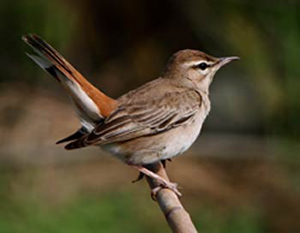
Çalı bülbülü ise 70 ayrı tür kuşa ait sesi taklit edebilir.
Birds, and in particular the group we have referred to as "sound imitators," have an astonishing talent for mimicry. This demonstrates that these creatures have a definite consciousness, for in order to use their talent, birds have to know what they want to imitate, the word's stress and intonation, evaluate its timing very carefully and then make a number of adjustments. Moreover, a bird must have a good memory to be able to remember and repeat the sounds it has heard.
At this point, it shouldn’t be overlooked that mimicry is a skill that even the majority of intelligent, conscious people do not possess. It is impossible or somewhat difficult for many of us to imitate songs or sounds we’ve heard in a way that’s true to the original. People who are talented mimics attract much attention and are praised for their keen powers of observation. But all members of a given species of parrot use their skills of mimicry effortlessly—another indication that they possess consciousness.
It should be pointed out, however, that the “consciousness” possessed by birds does not resemble ours. Man has skills that no other living creatures have such as the ability to think, make comparisons, understand, learn, draw conclusions from what we’ve learned, and use that knowledge for innovation. Above all, man is a being who is answerable to God for his deeds. In a verse of the Qur’an, God conveys the following:
It is He Who created the heavens and the Earth in six days when His Throne was on the water, in order to test which of you has the best actions… (Qur'an, 11:7)
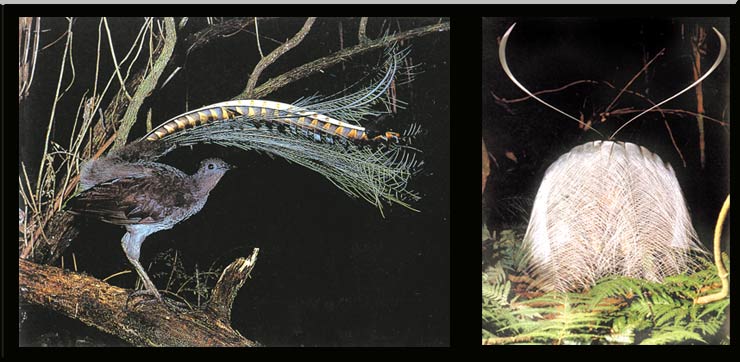
Çelenk kuyruklu kuş (lyrebird) dünyanın en iyi taklitçi kuşlarındandır. 12 farklı kuş türüne ait sesleri taklit edebilir. Bundan başka, kameranın motorunun pervane sesini, bir şalterin kapanma sesini, araba motorunun veya saat alarmının sesini çıkarabilir. Kendi bölgesinde kullanılan elektrikli testere sesini bile taklit edebilir.
As the verse says, man is responsible to God:
Then [He] formed him and breathed His Spirit into him and gave you hearing, sight and hearts... (Qur'an, 32:9)
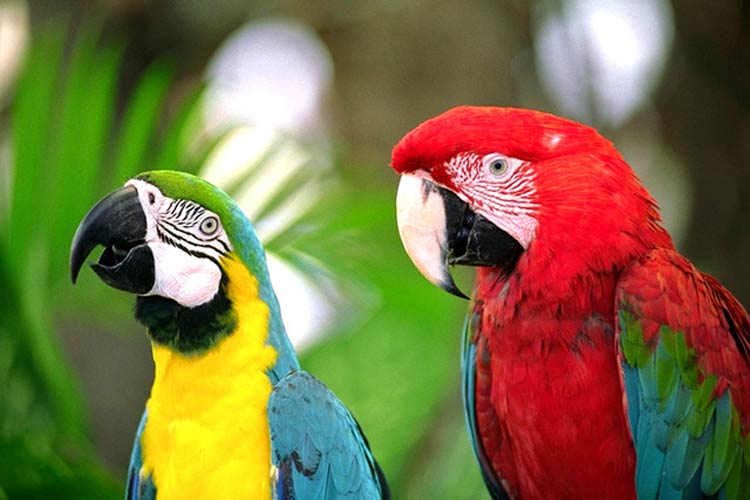
Göklerde ve yerde ne varsa O'nundur, itaat-kulluk da (din de) sürekli olarak O'nundur. Böyleyken Allah'tan başkasından mı korkup-sakınıyorsunuz? (Nahl Suresi, 52)
This conveys that man is given a "soul" by God, and will have to account for his deeds in this world. Birds and other animals do not have this responsibility; they merely have to carry out the tasks God has inspired in them and are instruments through which we may witness His supreme power. In a verse of the Qur'an, God declares the following:
Do you not see that everyone in the heavens and Earth glorifies God, as do the birds with their outspread wings? Each one knows its prayer and glorification. God knows what they do. (Qur'an, 24:41)
The Skills of Understanding and Learning in Birds
Of all the talking birds, the African grey parrot is known to be the most talented in respect to understanding and learning. Next come the Amazon parrots, especially yellow napes, the blue fronts, red loreds, and the double yellowheads. Macaws also have vocal learning, but usually vocalize in a loud and rough manner. Unlike the macaw, the cockatoo, another of the parrots with vocal learning, has a sweet voice. But neither species can be taught as easily as the African grey parrots or the Amazons. Mynahs are also known to be particularly good at speaking. One mynah, for example, when approached by a child, can say "Hello." And if the child responds with the same greeting, the bird can ask, "How are you?" Even more interesting, it can continue by asking, "What's your name?" 12
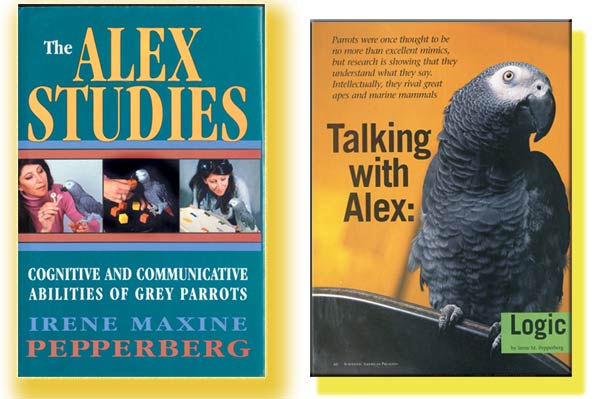
Prof. Irene Pepperberg'in 1977 yılından beri "hayvan davranışları ve hayvan-insan iletişimi" konusunda yaptığı çalışmalar, kuşların konuşma ve anlama yetenekleri hakkında derinlemesine bilgi vermiştir. Bilim adamları kuşların iletişimindeki kompleksliğin daha yeni yeni anlaşılmaya başlandığına inanmaktadırlar.
One of parrots' striking abilities is that they can relate their speech to subjects or movements. For example, a parrot greeted with "Good morning" every time the cover is taken off the cage can, one morning when the cover is removed, say the phrase of its own accord. You have probably heard from several owners that their birds can say, "Hello" when the phone rings or "Who is it?" when some one rings the doorbell. What's more, most birds can do this without being taught, since they can make connections between events and what is said at the time.
For a long time, it was believed that parrots and other talking birds simply imitate what they hear, but recent research has shown that these creatures have surprising cognitive abilities. Only recently have scientists begun to understand the complexity of the bird’s communication system. Studies conducted since 1977 by Professor Irene Pepperberg on the subject of animal behavior and animal-human communications give detailed information about birds’ skills in speaking and comprehension. In one of her most important works, the study was conducted with four African Grey Parrots. The oldest of them, “Alex,” could communicate with the researchers, use specific words, express his wishes, knew the concepts of “same” and “different,” could count and identify objects, colors, shapes and materials.13 According to scientists, these skills were not automatic, but the results of learning, which in turn is a sign of a high level of consciousness.14 Naturally this is the inspiration of God. It is ridiculous to imagine that a small piece of flesh composed of insentient atoms can exhibit such complex talents of its own accord. God shows us His incomparable creative art in the talents He has inspired in living creatures.
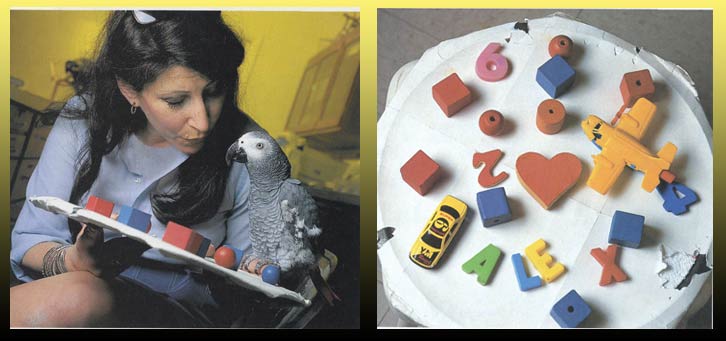
Prof. Irene Pepperberg'in eğittiği "Alex" adlı kuş sadece cümlecikleri üretmek ve kavramakla kalmamakta, aynı zamanda kendisine öğretilen kategori, miktar, renk ve boyut gibi kavramları da anlayabilmektedir. Hayvanlarda gördüğümüz bu yüksek şuur, Allah'ın canlılara olan ilhamıdır.
We will describe in greater detail the work of Professor Pepperberg and use some examples of Alex's behavior to show what a parrot is capable of doing. If we generalize about his skills, not only can he produce and comprehend sentences, but he also understands concepts of category, "same/different," absence, quantity, color and size. He can tell whether one object is different from another, and whether there is such an object in the room.15
- Alex has learned the names of more than 40 objects: paper, key, nut, wood, wheat, truck, "hide" (rawhide chips), "peg wood" (clothespins), grain, cork, corn, walnut, block, box, "showah" (shower), banana, pasta, gym, cracker, "scraper" (nail file), popcorn, chain, kiwi, shoulder, "rock" (a lava stone beak conditioner), carrot, gravel, cup, citrus, back, chair, chalk, water, nail, grape, grate, treat, cherry, wool, green bean, and "banerry" (apple).

Alex adlı bu eğitimli papağan farklı şekil ve renklerdeki nesnelerden kaç tanesinin yeşil üçgen ya da mavi dörtgen olduğunu söyleyebilmektedir. Bilinç ve akıldan yoksun canlıların öğrenme yeteneği geliştirmeleri, öğrendiklerini hafızalarında saklayıp, yerli yerinde kullanmaları Allah'ın bu canlılara olan ilhamıdır.
- He has functional use of “no,” phrases such as “Come here,” “I want—,” and “Wanna go—” using appropriate names for objects or locations.
- He has also acquired attributes. He can identify seven colors, “rose” (red), blue, green, yellow, orange, grey, and purple.
- He can name five different shapes as two-, three-, four, five -, or six-cornered objects. He uses “two,” “three,” “four,” “five,” and “sih” (six) to distinguish quantities, including groups of unfamiliar items, heterogeneous collections, and sets in which objects are arrayed at random.
- Alex has a limited comprehension of “category.” He has learned, for example, not only that “green” is one example of the category “color,” but also that for a particularly colored and shaped object, “green” and “three-corner” represent two of its different attributes. Thus he categorizes such objects with respect to either attribute based on our vocal query of “What color?” or “What shape?” Because the same object can be the subject of either a shape or a color question at different times, Alex must be able to change his basis for classification. Such an ability to reclassify is thought to indicate the presence of “abstract aptitude.”
- He can request or refuse more than 100 objects, categorize and count them, and combine adjectives with the names. In tests evaluating this skill, he has a success rate of 80%.
- Alex has also learned to answer questions concerning abstract concepts, such as “same” and “different.” For example, when shown two objects of the same color, shape or material, he knows which category the objects have in common, or in which category they are different. Or if the objects have no category in common, he is able to answer “none.”
- The studies also showed that Alex can give the right answers in regard to nouns, colors, shapes and materials not used in training sessions. For example, he can give the correct answer to the question of “What’s the same?” when presented with a green triangular piece of wood and a blue one.
- If a trainer hands Alex something different from what he asked for, Alex usually says “No” and repeats his original request. Moreover, he can correctly say which of two objects is the larger or the smaller. If they’re the same size, he answers, “None.”
- Given a series of objects of different shapes and colors, Alex can say how many of them are, for example, green triangles or blue squares. Able to sort different bottle tops according to size, he can also combine words to say “I want a green nut” or express wishes in simple sentences such as, “Come here.”
- To study the parrot’s conceptualization ability, Alex was asked, “What color is object X?” Out of 100 objects of different shapes, colors, and materials, he has a success rate of 81.3% in answering correctly. His correct answers show that he understands all the elements of the question and chooses the right answer by obtaining the required information from objects he is shown.
As Alex’s example shows, parrots given the necessary training can memorize fairly long sentences, use them appropriately, and use them to reply to various questions. In addition, they can recognize various words and combine them appropriately. Nowadays, parrots are rated along with dolphins and whales as possessing a high level of intelligence. About the intelligence and talents of parrots, The Augusta Chronicle has this to say:
New research suggests that parrots, like chimps and dolphins, are capable of mastering complex intellectual concepts that children cannot handle until age 5.16
Communication in animals—a dog's bark, for example—is usually innate behavior, not learned. In many species of birds, also, the basic sounds can be instinctive signals, innate and automatic. But the ability to imitate specific sounds is different matter that requires learning. Research shows that in species of birds such as the psittacine group (parrots, crested parrots, budgerigars), corvids (crows, ravens, jays) and the Cracticidae (Australian magpies, currawongs, butcherbirds) most vocal skills are learned behavior.17
We should not forget that these talents do not originate with the creatures in question. It is by God's inspiration that these creatures with no rationality develop learning skills and then store in memory what they learned and use it in context.
|
İnsanlardan, hayvanlardan ve davarlardan da renkleri böyle değişik olanlar vardır. Kulları içinde ise Allah'tan ancak alim olanlar 'içleri titreyerek-korkar'. Şüphesiz Allah, üstün ve güçlü olandır, bağışlayandır. (Fatır Suresi, 28)
|
|
SCIENTISTS ARE SURPRISED BY THE INTELLIGENCE MANIFESTED IN BIRDS
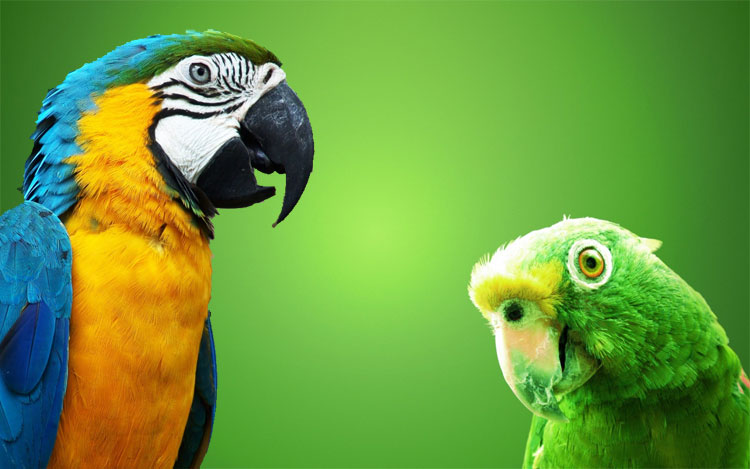
Carlio Melo, a brain researcher in Rockefeller University's animal behavior laboratory, says:
". . . in the beginning of the century up to the 30th and 40th, people believed that the brain of birds were very simple and they were considered primitive. And that created a lot of problems, a lot of prejudice actually. It's funny to think about this in science, but it does happen. … Birds are very, very intelligent in many ways… That means many birds, particularly those birds that have vocal learning such as song birds, parrots and hummingbirds, they have a very high brain to body ratio… That means these are very, very smart animals." *http://www.abc.net.au/worldtoday/s162563.htm
|
The Surprising Memory of Birds
Their skills in imitating sound are directly related to birds' ability to recall sounds they have heard. According to the research team at the Free University in Berlin, when conducting research into how a bird imitates sound, the following points should be addressed:
Vocal imitation which is so common in human beings is quite rare in nonhuman organisms. Until now, it has been documented only for a few families of birds (e. g. oscine birds and parrots) and some mammals (e. g. marine mammals and bats). As an inquiry into this accomplishment we study the properties of memory mechanisms that allow individuals to first acquire, then memorize and finally vocally imitate a set of auditorily experienced signal patterns. Our biological model is the Common Nightingale (Luscinia megarhynchos). Males of this species are able to auditorily learn and accurately reproduce more than 200 different types of songs. Thus, a central aim of our study is to uncover how these birds successfully cope with complex learning tasks, and how they effectively retrieve their memory-stored data later in life…18
Birds' have memories of surprisingly high capacity. Not only do they recall the exact location of where they spend their summers and winters, but also the precise location of various foodstuffs they have stored for use in the winter and of plants whose nectar they have drunk. In fact, some birds have longer-term memories than humans. In order to survive cold winter days of heavy snow, some bird species bury thousands of seeds in autumn and remember all of those different places when winter comes, months later. 19
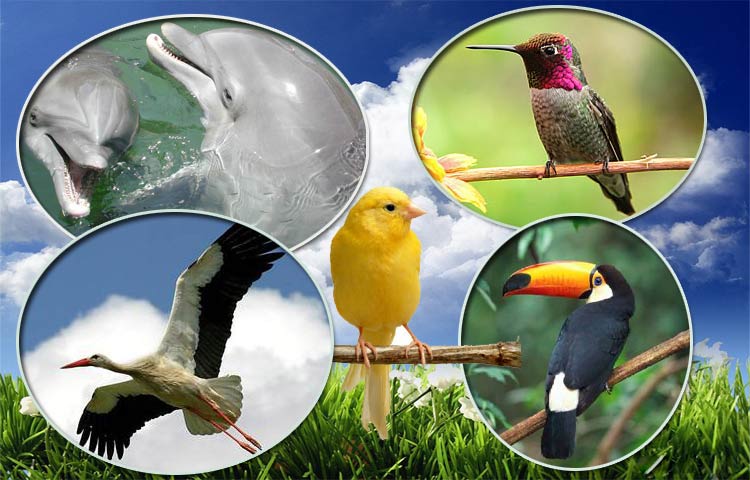 İnsan dilinin bir özelliği olan seslendirmeyi öğrenmek hayvanlarda çok nadir rastlanan bir özelliktir. Bu özelliğin çok az sayıda hayvanda olduğu bilinmektedir: 3 grup kuş (papağanlar (psittaciformes), ötücü kuşlar (oscine passeriformes) ve sinek kuşları (trochiliformes)) ve memelilerden de yarasalar, balinalar-yunuslar (cetaceans)... Diğer hayvan türlerinin tamamının yalnız doğuştan gelen sesleri ürettikleri bilinmektedir. İnsan dilinin bir özelliği olan seslendirmeyi öğrenmek hayvanlarda çok nadir rastlanan bir özelliktir. Bu özelliğin çok az sayıda hayvanda olduğu bilinmektedir: 3 grup kuş (papağanlar (psittaciformes), ötücü kuşlar (oscine passeriformes) ve sinek kuşları (trochiliformes)) ve memelilerden de yarasalar, balinalar-yunuslar (cetaceans)... Diğer hayvan türlerinin tamamının yalnız doğuştan gelen sesleri ürettikleri bilinmektedir.
It’s certainly a miracle that a bird has such a capacity for memory and learning. At the same time, this makes nonsense of evolutionists’ claims that creatures evolved. Evolutionary theory cannot explain how birds are able to store in memory sounds they have heard and then use them appropriately. Evolutionary assertions cannot explain how birds have come to possess such a memory. (For detailed information, see the chapter headed “Talking Birds Invalidate Evolutionary Claims”).
It’s not possible for a bird to set up a system for storing what it has learned in its tiny brain. It’s similarly impossible for a special structure to form in a bird’s brain by chance. Birds’ ability to recall sounds and information is just one of the many talents God has granted to these creatures.
Tests Conducted on Talking Birds
God has granted to talking birds some extraordinary talents, as revealed in studies conducted on African Grey parrots (Psittacus erithacus) by Professor Irene Pepperberg.
In the course of their studies, Pepperberg and her colleagues conducted simple but meaningful conversations with Alex rather than repeating meaningless words or phrases over and over. One person would ask—and the other answer—such questions as, "What shape is the wood?" "How many?" and "What object is blue?" The one asking the questions praised the other party for correct answers. The same study was repeated using the same model and content, but different categories. After these studies, when Alex used the words appropriately, he was given the object he asked for and told that he was "a good boy." By this training method, as already mentioned, Alex learned the names of more than 100 objects, and to respond correctly to questions relating to their shapes, colors and structures.20 By observing the two people talking, he could understand what those carrying out the test were saying to him and could respond to them in a meaningful way. Most of the time, he listened to two people asking each other questions in a systematic way. After a time, he started expressing wishes such as "Tickle me" or "I want popcorn." When offered something other than the food he asked for, he would refuse it and repeat his request. He would ask to be taken to different places—for example, "Wanna go chair." If taken to the wrong place, he would stay on the person's arm and repeat what he wanted.

Allah'ın dilemesi ile bu hayvanlar, kendi beyin kapasitelerinden beklenmeyecek ölçüde üstün bir yetenek göstermekte ve insanları hayrete düşürecek davranışlar sergilemektedirler.
In another test, Alex was shown a tray of seven objects like a purple key, yellow wood, green leather, blue paper, an orange peg, gray box, and a red truck; and asked which one was gray, Alex would look carefully at all seven objects and answer, "Box." A red paper triangle and a blue wooden triangle were put on the tray. When asked what was the same, he answered, "Shape." 21
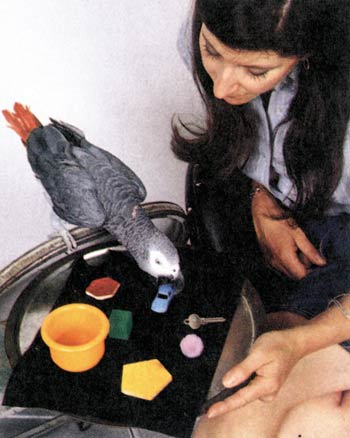
Research and tests conducted on parrots and other talking birds are not just limited to Alex. Another rather surprising example is a small parrot named Blue Bird. Within a few weeks of the project's start, this bird started talking in a meaningful way and learned to ask for things understandably. When he wanted someone to open the door of his cage or any other door, he could use phrases like, "Open the door," "Can I have some?" when he wanted something someone was eating, or "Take a shower" when he wanted someone to turn the water on so he could bathe.22
Blue Bird wasn't taught words directly or formally. Instead, his trainer, Sheryl C. Wilson, would say words slowly and in context, for example, "Open the door" on opening the door of his cage. The bird seemed to understand. Using this method, in a short time he began to use these words in their proper context: "How are you?" "Whatcha doing?" "Where you going?" "Hello," "Good morning," "Good night" and "Such a sleepy little birdie." He could also comprehend and obey Wilson's requests such as "Get down," "Please go into your cage," and "No!" Whenever his owner called, the bird would fly straight to her. 23
All this information shows how some birds can, in common with humans, use general and abstract concepts and remember information stored in their memory. As with parrots, which have the appropriate anatomical structures to imitate human sounds, certain other birds can also talk to us in a meaningful way. No doubt they urge us to think of them as indicators of the knowledge and wisdom in God's creation. It is God Who creates birds with diverse talents like speech and mimicry. By His will, these creatures exhibit behavioral skills that surpass expectations of their brain capacity to an astonishing degree. This, together with thousands of similar examples in nature, lets people see God's power, strengthening the faith of those who already believe and allowing many who do not know God as they should to consider the reality of creation.
God has commanded us to ponder the vast evidence in the skies and upon Earth. However, it should not be forgotten that only those who listen to the voice of their conscience will be able to see this manifest evidence and conceptualize its meaning with God's consent:
Have they not looked at the sky above them: How We structured it and made it beautiful and how there are no fissures in it? And the Earth: how We stretched it out and cast firmly embedded mountains onto it and caused luxuriant plants of every kind to grow in it, an instruction and a reminder for every penitent human being. (Qur'an, 50:6-8)
PAPAĞAN VE MUHABBET KUŞLARININ KONUŞMALARINDAN ÖRNEKLER...
 YARAMAZ, YARAMAZ ÇOCUK! YARAMAZ, YARAMAZ ÇOCUK! |
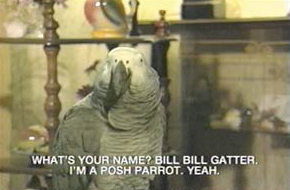 SENİN ADIN NE? BILL, BILL GATTER. BEN ŞIK BİR PAPAĞANIM. EVET. SENİN ADIN NE? BILL, BILL GATTER. BEN ŞIK BİR PAPAĞANIM. EVET. |
 HADİ, KONUŞ BENİMLE! HADİ, KONUŞ BENİMLE! |
 ... BİR KÖPEK NE DER? HAV HAV. BİR KÖPEK NE DER? MİYAV. ... BİR KÖPEK NE DER? HAV HAV. BİR KÖPEK NE DER? MİYAV. |
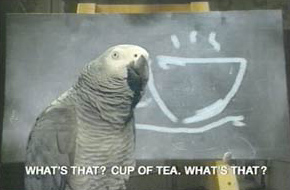 O NEDİR? BİR FİNCAN ÇAY. O NEDİR? O NEDİR? BİR FİNCAN ÇAY. O NEDİR? |
 SENİ GÖREBİLİYORUM. BOO! SENİ GÖREBİLİYORUM. BOO! |
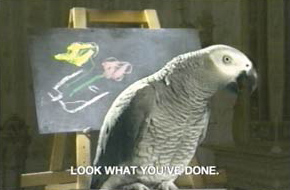 BAK NE YAPTIN. BAK NE YAPTIN. |
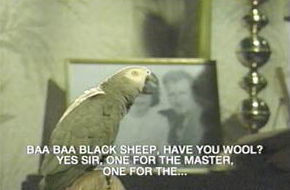 KARA KOYUN. YÜNÜN VAR MI? EVET EFENDİM. BİR TANE SAHİP İÇİN. BİR TANE... KARA KOYUN. YÜNÜN VAR MI? EVET EFENDİM. BİR TANE SAHİP İÇİN. BİR TANE... |
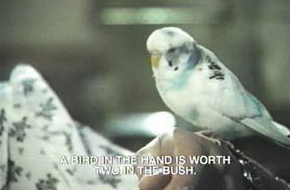 ELDEKİ BİR KUŞ, ÇALIDAKİ İKİ KUŞA BEDELDİR. ELDEKİ BİR KUŞ, ÇALIDAKİ İKİ KUŞA BEDELDİR. |
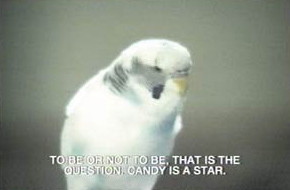 OLMAK YA DA OLMAMAK. İŞTE BÜTÜN MESELE BU. CANDY (ŞEKER) BİR YILDIZ. OLMAK YA DA OLMAMAK. İŞTE BÜTÜN MESELE BU. CANDY (ŞEKER) BİR YILDIZ. |
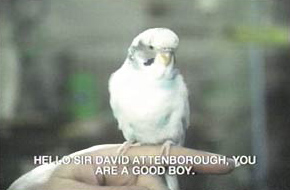 MERHABA BAY DAVID ATTENBOROUGH. SİZ İYİ BİRİSİNİZ. MERHABA BAY DAVID ATTENBOROUGH. SİZ İYİ BİRİSİNİZ. |
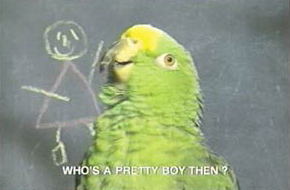 ÖYLEYSE SEVİMLİ ÇOCUK KİM? ÖYLEYSE SEVİMLİ ÇOCUK KİM? |
Yukarıdaki kareler Nature yayınlarının "Parrots: Look Who's Talking" (Papağanlar: Bakın Kim Konuşuyor) adlı belgeselinden alınmıştır. Burada yer verdiğimiz ifadeler papağanların ve muhabbet kuşlarının öğrenebildikleri cümlelerden sadece birkaçıdır.

Kendinden (bir nimet olarak) göklerde ve yerde olanların tümüne sizin için boyun eğdirdi. Şüphesiz bunda, düşünebilen bir kavim için gerçekten ayetler vardır. (Casiye Suresi, 13)
Communication and Signaling in Birds
Birds produce meaningful communications by their facial expressions, beak movements, feather ruffling, elongating their necks, crouching, bouncing, and flapping their wings. Although each species has its own body language, many different species interpret movements in the same way. For example, various species interpret an upward thrust of the beak as expressing the intention to fly, and the lowering of the breast as a warning of danger. Also, several species perceive raising the tail feathers as a threat, or displaying bright colors atop of the head as a declaration of the intent to attack. Via facial expression, birds can convey a variety of messages to those around them—negative feelings such as dislike and resentment, as well as positive ones like pleasure, enthusiasm and curiosity.24
Birds produce different facial expressions by movements of the beak, or by positioning the feathers above the beak, on the chin, or atop the head. In some species, the feathers above the eye can also move independently. Moreover, many species make a display by opening their beaks. For example, the tawny frogmouth opens its beak to reveal its large, bright green oral cavity, emphasizing the size of its beak and making it appear more intimidating. Some other species open their beaks as a form of threatening behavior, usually silently, but sometimes enhance the performance with hissing or loud breathing.25
Besides communicating by means of body language, birds produce a great variety of sounds to communicate with other members of their flock, neighbors, or family members. These range from short, simple calls to songs that are surprisingly long and complex. Sometimes birds such as the green woodpecker use different instruments or, like the American woodpecker, use special feathers to produce sound.
Birds also communicate through smell, though since their sense of smell is poor, their communication is based mainly on sound and sight. At times of poor visibility, as at night or in dense foliage, sound is most advantageous, and is also the ideal method for long-distance communication. If conditions are right, birdsong can be heard for up to a few kilometers.
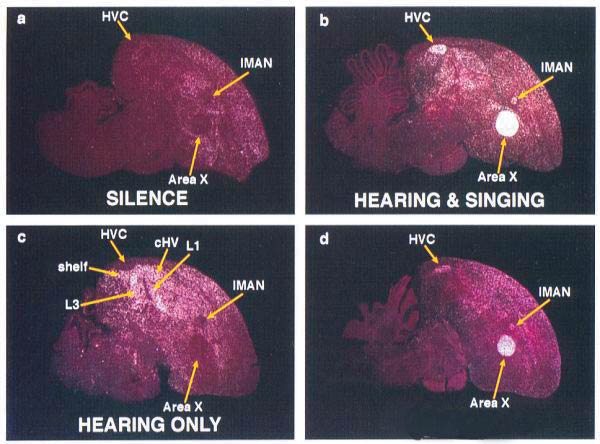
a- SESSİZLİK b- İŞİTME VE ŞARKI SÖYLEME c- SADECE İŞİTME d- SADECE ŞARKI SÖYLEME
Yukarıdaki resimlerde, ötücü kuşlardan olan kanaryanın işitme ve şarkı söyleme sırasında beyninde aktif olan bölgeler gösterilmektedir.
As we have seen in the example of Alex, the African Grey, birds also have conceptualization and communication skills. In certain circumstances, they demonstrate talents equivalent to those of children of primary-school age, learning series of words and other means of human communication through social interaction. When alone, these parrots play vocalization games and when in the company of people, they join vocalizations together to produce new assemblages from existing sequences of speech. God, the Creator of everything on Earth and in the skies, equips them with the talents and characteristics that set them apart. Accordingly, our praises for the supreme beauty of our environment is praise that belongs to God.
The Language of Calls and Songs
To call one another, birds produce sounds of extremely high frequency and strength. Only a few species such as pelicans, storks, and certain vultures have no call. The acoustic calls used by birds amongst themselves form a language of sorts. Their songs, which are longer and generally related to courtship, consist of a series of notes and usually contain melodies.
To call one another, birds produce sounds of extremely high frequency and strength. Only a few species such as pelicans, storks, and certain vultures have no call. The acoustic calls used by birds amongst themselves form a language of sorts. Their songs, which are longer and generally related to courtship, consist of a series of notes and usually contain melodies. .26 These calls' main functions can be listed as follows:
-
to establish a bird's species
-
to indicate the bird's gender
-
to indicate the bird's gender
-
to demarcate and defend a territory
-
to advertise a source of food
-
to let young birds recognize their parents
-
to keep the flock together
-
to warn of the presence of an enemy
-
to intimidate an enemy
-
to intimidate an enemy
-
to mark the changeover of responsibility for nesting duties such as incubating or feeding
-
to practice and perfect songs
Usually, birdsong is not composed of randomly produced sounds. Songs are exceptionally diverse melodies of specific meaning, sung for a purpose, and are much more complex than the calls used for signaling. They are generally used by males to advertise and defend a territory, or in courtship. It is also believed that songs serve a social function. When a pair is building their nest, they also establish communication by song. Experiments on caged birds have also demonstrated that birds find it easier to learn songs if another bird is present, but out of sight, in another cage.27
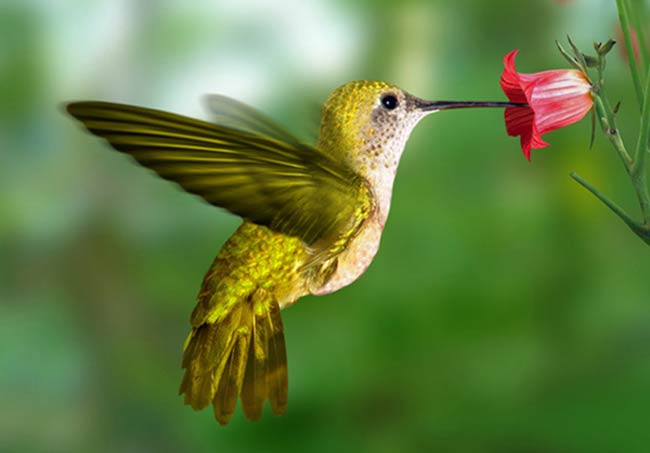 Sinek kuşlarının şarkıları ve bunları nasıl öğrendikleri araştırmacıları hayrete düşürmüştür. Her şarkı bireyin kendine özeldir. Sinek kuşları, doğuştan gelen bir özellik olarak değil, anne babalarından öğrenerek şarkı söylerler. (http://www.abc.net.au/worldtoday/s162563.htm) Sinek kuşlarının şarkıları ve bunları nasıl öğrendikleri araştırmacıları hayrete düşürmüştür. Her şarkı bireyin kendine özeldir. Sinek kuşları, doğuştan gelen bir özellik olarak değil, anne babalarından öğrenerek şarkı söylerler. (http://www.abc.net.au/worldtoday/s162563.htm)
Male and female songbirds have different brain structures, particularly in the regions related to sound production. With many songbird species, the males can sing, but the females cannot. The males use "song" to call their mates or designate a tree, pole, or electrical cable as a place to perch. Each species sings a song with its own characteristics, but any given species' songs display variations according to age, sex, particular time of year, and geographical location—appropriate for the environment in which they live. For example, birds that live in meadows use "songs of flight." Similarly, ones that live in the dense foliage of rain forests or reed thickets have loud voices to compensate for reduced visibility.
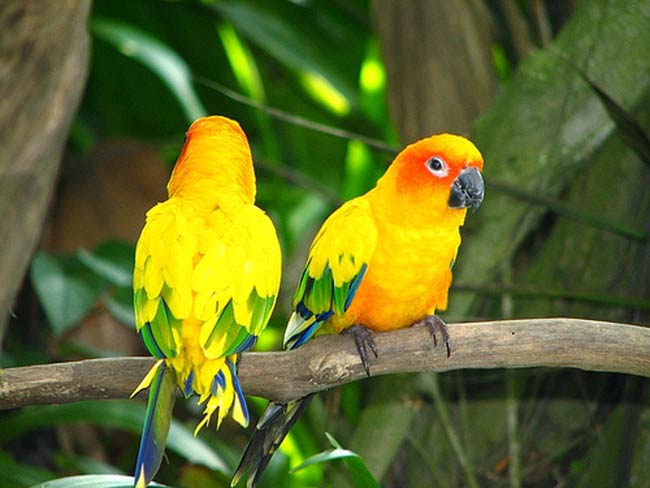 Uyarı seslenişinin yapıldığı yer kolay belirlenemez. Bir kaynağı duymak ve yerini belirlemek genellikle iki kulakla başarılır. Kuşlar da kulakları sayesinde, yoğunluk ve zaman farkı gibi mesajın önemli unsurlarını değerlendirir ve karşılaştırırlar. Böylece mesajın şifresini çözer ve gönderenin yerini belirlerler. Ses dalgasının bir kulağa ve sonra diğer kulağa ulaşması arasındaki zaman farkı, düşük frekanslarda daha etkili bir netice verir. Frekans yükseldikçe sesin dalga boyu düşer, dinleyicinin başının büyüklüğüne göre dalga boyları arasındaki farkı anlamak güçleşir. Bu yüzden de sesin kaynağının yerini belirlemek zorlaşır. Öte yandan dinleyicinin kulak aralığının mesafesine bağlı olarak, her bir kulağa sesin ulaşması arasındaki zaman farkını kullanarak, sesin kaynağını tespit etmenin imkansız olduğu bir ses frekansı da vardır. Eğer bir kuş bu frekansı, alarm olarak kullanmışsa kendisini de doğal olarak düşmanından korumuş olur. (Lesley J. Rogers & Gisela Kaplan, Songs, Roars and Rituals, Communication In Birds, Mammals and Other Animals, USA, 2000, ss. 93-94) Bu üstün yetenek Allah'ın kuşlarda tecelli ettirdiği yaratılış harikalarından biridir. Uyarı seslenişinin yapıldığı yer kolay belirlenemez. Bir kaynağı duymak ve yerini belirlemek genellikle iki kulakla başarılır. Kuşlar da kulakları sayesinde, yoğunluk ve zaman farkı gibi mesajın önemli unsurlarını değerlendirir ve karşılaştırırlar. Böylece mesajın şifresini çözer ve gönderenin yerini belirlerler. Ses dalgasının bir kulağa ve sonra diğer kulağa ulaşması arasındaki zaman farkı, düşük frekanslarda daha etkili bir netice verir. Frekans yükseldikçe sesin dalga boyu düşer, dinleyicinin başının büyüklüğüne göre dalga boyları arasındaki farkı anlamak güçleşir. Bu yüzden de sesin kaynağının yerini belirlemek zorlaşır. Öte yandan dinleyicinin kulak aralığının mesafesine bağlı olarak, her bir kulağa sesin ulaşması arasındaki zaman farkını kullanarak, sesin kaynağını tespit etmenin imkansız olduğu bir ses frekansı da vardır. Eğer bir kuş bu frekansı, alarm olarak kullanmışsa kendisini de doğal olarak düşmanından korumuş olur. (Lesley J. Rogers & Gisela Kaplan, Songs, Roars and Rituals, Communication In Birds, Mammals and Other Animals, USA, 2000, ss. 93-94) Bu üstün yetenek Allah'ın kuşlarda tecelli ettirdiği yaratılış harikalarından biridir.
Knowing which song to sing in which environment, and the meaning and purpose of each song, are not something that each individual bird can work out for itself. Behavior indicative of such wisdom and foresight by creatures with no reason or judgment exhibits the inspiration of God in living creatures. He creates each creature with its necessary characteristics and inspires its rational behavior.
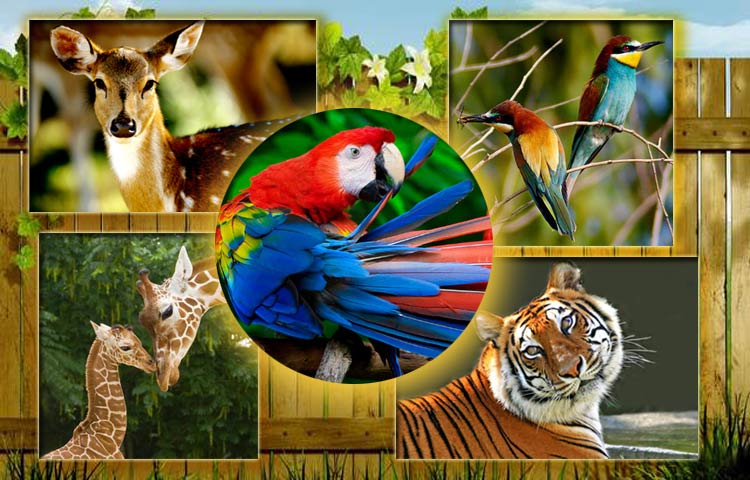
Gökleri ve yeri yaratan, onların bir benzerini yaratmağa kadir değil mi? Elbette (öyledir); O, yaratandır, bilendir. Bir şeyi dilediği zaman, O'nun emri yalnızca: "Ol" demesidir; o da hemen oluverir. (Yasin Suresi, 81-82)
|















 YARAMAZ, YARAMAZ ÇOCUK!
YARAMAZ, YARAMAZ ÇOCUK! SENİN ADIN NE? BILL, BILL GATTER. BEN ŞIK BİR PAPAĞANIM. EVET.
SENİN ADIN NE? BILL, BILL GATTER. BEN ŞIK BİR PAPAĞANIM. EVET. HADİ, KONUŞ BENİMLE!
HADİ, KONUŞ BENİMLE! ... BİR KÖPEK NE DER? HAV HAV. BİR KÖPEK NE DER? MİYAV.
... BİR KÖPEK NE DER? HAV HAV. BİR KÖPEK NE DER? MİYAV. O NEDİR? BİR FİNCAN ÇAY. O NEDİR?
O NEDİR? BİR FİNCAN ÇAY. O NEDİR? SENİ GÖREBİLİYORUM. BOO!
SENİ GÖREBİLİYORUM. BOO! BAK NE YAPTIN.
BAK NE YAPTIN. KARA KOYUN. YÜNÜN VAR MI? EVET EFENDİM. BİR TANE SAHİP İÇİN. BİR TANE...
KARA KOYUN. YÜNÜN VAR MI? EVET EFENDİM. BİR TANE SAHİP İÇİN. BİR TANE... ELDEKİ BİR KUŞ, ÇALIDAKİ İKİ KUŞA BEDELDİR.
ELDEKİ BİR KUŞ, ÇALIDAKİ İKİ KUŞA BEDELDİR. OLMAK YA DA OLMAMAK. İŞTE BÜTÜN MESELE BU. CANDY (ŞEKER) BİR YILDIZ.
OLMAK YA DA OLMAMAK. İŞTE BÜTÜN MESELE BU. CANDY (ŞEKER) BİR YILDIZ. MERHABA BAY DAVID ATTENBOROUGH. SİZ İYİ BİRİSİNİZ.
MERHABA BAY DAVID ATTENBOROUGH. SİZ İYİ BİRİSİNİZ. ÖYLEYSE SEVİMLİ ÇOCUK KİM?
ÖYLEYSE SEVİMLİ ÇOCUK KİM?






